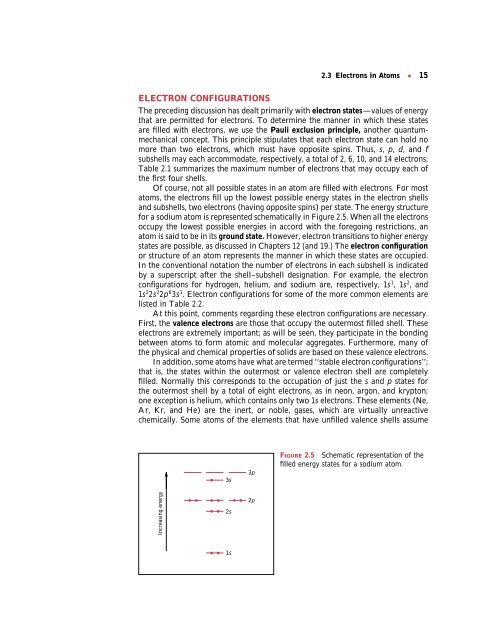Chapter 2 / Atomic Structure and Interatomic Bonding
Chapter 2 / Atomic Structure and Interatomic Bonding
Chapter 2 / Atomic Structure and Interatomic Bonding
Create successful ePaper yourself
Turn your PDF publications into a flip-book with our unique Google optimized e-Paper software.
ELECTRON CONFIGURATIONS<br />
2.3 Electrons in Atoms ● 15<br />
The preceding discussion has dealt primarily with electron states—values of energy<br />
that are permitted for electrons. To determine the manner in which these states<br />
are filled with electrons, we use the Pauli exclusion principle, another quantummechanical<br />
concept. This principle stipulates that each electron state can hold no<br />
more than two electrons, which must have opposite spins. Thus, s, p, d, <strong>and</strong> f<br />
subshells may each accommodate, respectively, a total of 2, 6, 10, <strong>and</strong> 14 electrons;<br />
Table 2.1 summarizes the maximum number of electrons that may occupy each of<br />
the first four shells.<br />
Of course, not all possible states in an atom are filled with electrons. For most<br />
atoms, the electrons fill up the lowest possible energy states in the electron shells<br />
<strong>and</strong> subshells, two electrons (having opposite spins) per state. The energy structure<br />
for a sodium atom is represented schematically in Figure 2.5. When all the electrons<br />
occupy the lowest possible energies in accord with the foregoing restrictions, an<br />
atom is said to be in its ground state. However, electron transitions to higher energy<br />
states are possible, as discussed in <strong>Chapter</strong>s 12 <strong>and</strong> 19. The electron configuration<br />
or structure of an atom represents the manner in which these states are occupied.<br />
In the conventional notation the number of electrons in each subshell is indicated<br />
by a superscript after the shell–subshell designation. For example, the electron<br />
configurations for hydrogen, helium, <strong>and</strong> sodium are, respectively, 1s 1 ,1s 2 , <strong>and</strong><br />
1s 2 2s 2 2p 6 3s 1 . Electron configurations for some of the more common elements are<br />
listed in Table 2.2.<br />
At this point, comments regarding these electron configurations are necessary.<br />
First, the valence electrons are those that occupy the outermost filled shell. These<br />
electrons are extremely important; as will be seen, they participate in the bonding<br />
between atoms to form atomic <strong>and</strong> molecular aggregates. Furthermore, many of<br />
the physical <strong>and</strong> chemical properties of solids are based on these valence electrons.<br />
In addition, some atoms have what are termed ‘‘stable electron configurations’’;<br />
that is, the states within the outermost or valence electron shell are completely<br />
filled. Normally this corresponds to the occupation of just the s <strong>and</strong> p states for<br />
the outermost shell by a total of eight electrons, as in neon, argon, <strong>and</strong> krypton;<br />
one exception is helium, which contains only two 1s electrons. These elements (Ne,<br />
Ar, Kr, <strong>and</strong> He) are the inert, or noble, gases, which are virtually unreactive<br />
chemically. Some atoms of the elements that have unfilled valence shells assume<br />
Increasing energy<br />
3s<br />
2s<br />
1s<br />
3p<br />
2p<br />
FIGURE 2.5 Schematic representation of the<br />
filled energy states for a sodium atom.



